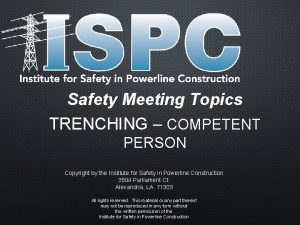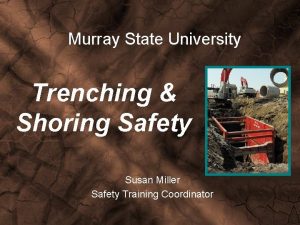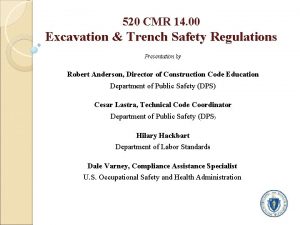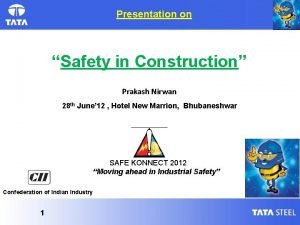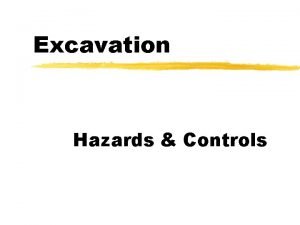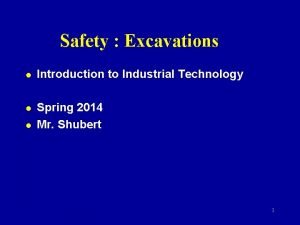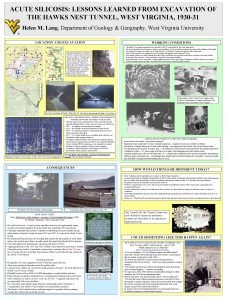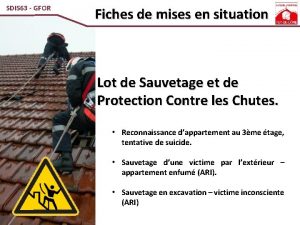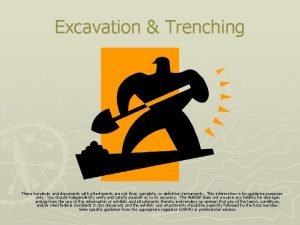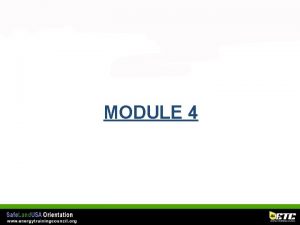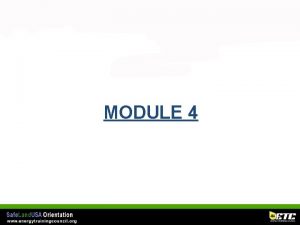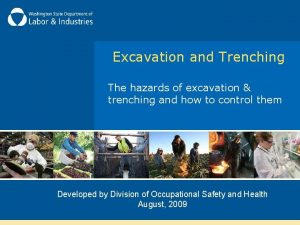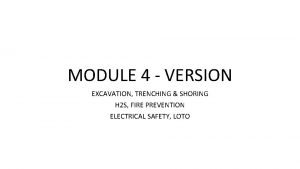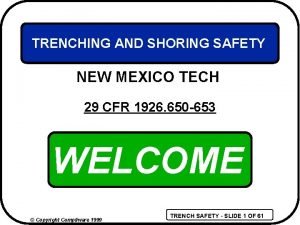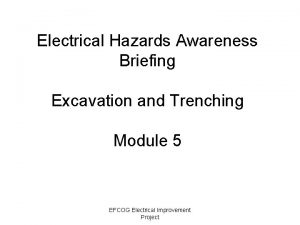Excavation Trenching Shoring Excavation Trenching Shoring Excavating is
























































































































- Slides: 120

Excavation (Trenching & Shoring)

Excavation – Trenching & Shoring • Excavating is one of the most hazardous forms of construction activity due to the possibility of cave-ins. • Excavating emergencies are more likely to result in a serious injury or fatality than any other construction accident. • Trench accidents result in approximately 100 fatalities per year.

Excavation – Trenching & Shoring § Site workers are those employees working on a site or location that has an excavation project. § Site workers are not authorized to work on the excavation project.

Excavation – Trenching & Shoring § Competent person is one who is capable of detecting conditions leading to caveins, failures in protective systems and hazardous conditions. § A competent person has AUTHORITY to fix what is wrong.

Excavation – Trenching & Shoring Work Practices 1. Good work practices shall include proper training of all employees on dangers associated with trenching and shoring. 2. No employee shall be allowed on or around an excavation without proper personal protective equipment including atmospheric monitoring devices.

Excavation – Trenching & Shoring • No employee shall be allowed on or around an excavation that does not have a shoring system in place, if necessary. • Atmospheric testing shall be done before entering the trench and periodically during work to ensure things are still okay.

Excavation – Trenching & Shoring All underground hazards shall be identified before work begins. Utilize ONE CALL – 811

Excavation – Trenching & Shoring Employees shall not work in excavations where there is an accumulation of water unless precautions have been taken to protect employees. • Precautions should include but are not limited to: • Special support or shield systems • Water removal or control • Safety harness with lifeline

Excavation – Trenching & Shoring Other rescue equipment shall include: • Breathing equipment • Basket stretcher • Attendees

Excavation – Trenching & Shoring Hazards • Oxygen deficient atmospheres. • Loose rocks or soil. • Overhead loads being carried/lifted by digging equipment.

Excavation – Trenching & Shoring Personal Protective Equipment (PPE) • Respirators – employees must be fit tested and have proper training before use. Hazardous Atmospheres • <19. 5% or >23. 0% Oxygen (MN 5207. 300) • Combustible gas >10% LEL (LFL) • Concentrations of toxic materials > TLV established by ACGIH

Excavation – Trenching & Shoring • Some trenches qualify as a confined space. Therefore compliance with the Confined Space regulations would be required. • Atmospheric testing shall be done: • Before employees enter the area • Periodically to ensure the atmosphere is still safe. • Periodic testing shall increase if you are operating equipment in the trench.

Excavation – Trenching & Shoring Emergency & Non-Entry Rescue • In the event of an emergency situation requiring rescue, personnel SHALL NOT attempt to enter an unprotected trench to perform rescue. • Call emergency services in your area. • Rescue services that can be performed safely from outside the excavation, such as hoisting a harnessed victim, shall be undertaken.

Review

Hydrogen Sulfide Awareness H 2 S

Hydrogen Sulfide Awareness • Hydrogen Sulfide (H 2 S) gas is deadly in relatively low concentrations. • H 2 S gas is created by the decomposition of animal or vegetable matter. • H 2 S gas may be found in oil and gas wells, storage tanks, sewers, mines, gas plants and refineries. • What you don’t know can hurt you!

Hydrogen Sulfide Awarenss Hydrogen Sulfide (H 2 S) gas is referred to by many names: • Rotten egg gas • Stink gas • Sour gas • Sulfureted Hydrogen gas • Sewer gas • Devil’s breath

Hydrogen Sulfide Awarenss (H 2 S) Properties and Characteristics • Extremely Toxic: Six times more deadly than carbon monoxide, second only to hydrogen cyanide used in death chambers. • Skin Irritation: Not absorbed by skin but forms a sulfuric acid solution when combined with moisture such as perspiration. • Eye Irritation: causes severe pain.

Hydrogen Sulfide Awareness (H 2 S) Properties and Characteristics • Colorless: Not visible in air. • Odor: Smells like rotten eggs at lower concentrations. Higher concentrations will deaden sense of smell. • Heavier than Air: Unless dispersed by wind, H 2 S will settle in low lying areas such as pits, cellars, ravines, or enclosures. Specific gravity is 1. 189.

Hydrogen Sulfide Awareness (H 2 S) Properties and Characteristics • Highly Corrosive: Causes metal fatigue. • Highly Flammable: Does not require a spark to ignite! Any heated surface of at least 500° Fahrenheit can cause ignition. • Lower exposure limit (LEL) or 4. 3% or 4, 300 PPM and upper exposure limit (UEL) of 46% or 460, 000 PPM. (1400° F)

Hydrogen Sulfide Awareness (H 2 S) Properties and Characteristics • Burns with a Blue Flame: When burning, H 2 S will produce sulfur dioxide which is also extremely toxic and has a pungent smell. Sulfur Dioxide (SO 2)is easily disbursed by the wind. • Combines Easily with Other Liquids: It frees itself when released into the air.

Hydrogen Sulfide Awareness Possible Symptoms of H 2 S Exposure: • • • Eye irritation Fatigue Throat irritation Skin irritation Headache Nausea • • • Dizziness Loss of consciousness Vomiting Irrational behavior Coughing Excitement

Hydrogen Sulfide Awareness Toxicity Table: 0. 13 ppm Minimal perceptible odor. 4. 6 ppm Easily detectable, moderate odor. 10 ppm Beginning eye irritation Need PPE - Threshold Limit Value 27 ppm Strong, unpleasant odor, but not intolerable. 100 ppm Coughing, eye irritation, loss of sense of smell after two to five minutes. IDLH - Immediate Danger to Life and Health 200 -300 Respiration irritation after one hour. Burns ppm eyes and throat.

Hydrogen Sulfide Awareness Toxicity Table: 500 -700 ppm 700 - 1000 ppm 1000 - 2000 ppm Loss of consciousness and possible death in 30 minutes to one hour. Rapid unconsciousness at once, cessation (stopping or pausing) of respiration and death. Unconsciousness at once, with early cessation of respiration and death in a few minutes. Greater than 2000 ppm: DEATH OCCURS ppm = Parts of gas per million - part of air by volume - 1% = 10, 000 1 scoop of ice cream in a tanker full of Root beer.

Hydrogen Sulfide Awareness Well Site Safety • H 2 S warning signs are to be posted when H 2 S gas may be present. • At sites where concentrations exceed the action levels, H 2 S gas detectors (portable or fixed) with an alarm, guy wire flagging, wind socks, and appropriate warning signs are to be placed around the well site.

Hydrogen Sulfide Awareness Well Site Safety • Colored flags may also designate the potential danger of the H 2 S exposure. § Green Flag – Normal § Yellow Flag – Potential Danger (1 ppm to 20 ppm) § Red Flag – Extreme Danger (over 20 ppm)

Hydrogen Sulfide Awareness • Employees are to be trained on the use of breathing equipment, its location for use in an emergency and First Aid/CPR techniques. • A pre-work safety meeting is to be conducted to review the H 2 S safety evacuation and rescue procedures. • The buddy system is to be used to account for all personnel.

Hydrogen Sulfide Awareness • If the event of an H 2 S alert and the monitor alarm sounds, employees are to evacuate quickly moving up wind or cross wind, and to high ground. • Check the wind sock or guy wire flags to determine wind direction.

Hydrogen Sulfide Awareness In the Event of H 2 S Exposure: • Rescue only after donning proper breathing equipment. • Move victim upwind or crosswind away from H 2 S. • Initiate rescue breathing if breathing has stopped. If you are trained to do so, you may use a resuscitator. • After victim has received treatment, seek medical attention.

Hydrogen Sulfide Awareness • Keep victim warm. • Wash eyes with saline or clear water if eyes are affected. • Medical observation by a doctor is required until the victim is released to return to work.

Hydrogen Sulfide Awareness Detection Devices • Detection of H 2 S can only be accomplished with the use of special equipment. • Federal laws stipulate a maximum exposure or threshold limit for workers in an eight-hour work day – not to exceed 10 ppm.

Hydrogen Sulfide Awareness § Piston Pump or Bellows Pump: Both use hydrocyanic acid tubes. Tubers are marked in ppm or a percent. These are accurate and dependable and must be NIOSH certified.

Hydrogen Sulfide Awareness • Electronic Personal Detectors: Detectors that mount on your body or are handheld. Designed to give off an alarm when exposed to a predetermined level of H 2 S. • Audible • Visible • Vibration

Hydrogen Sulfide Awareness • Fixed Systems: Fixed systems continuously monitor air for H 2 S presence and an alarm is activated when H 2 S is detected. Used in larger plants or when continuous monitoring is required at the well site.

Review

Fire Safety (Prevention & Protection)

Fire Safety – Prevention and Protection • Fires are classified by the type of fuel they burn. • The four types are: D

Fire Safety – Prevention and Protection • Class A Fires & Extinguishers • Work by cooling. • Used on wood, paper, some rubber, plastic and rags. • Numerical rating indicates amount of agent duration and range of discharge on the test fire. Must be within 75’ or less of fire scene. • The area a “non-expert” can extinguish with proper training is: • 1 -A – equivalent to 5 liters of water. • 2 -A – equivalent to 10 liters of water.

Fire Safety – Prevention and Protection Class B Fires & Extinguishers • Work by blanketing the fuel. • Used on gasoline, diesel, oil, greases, paint, rubber or other flammable or combustible liquids. • Must be within 50’ or less of fire scene. • Class B ratings signify the area in square feet of flammable liquid fire a unit will extinguish when used by a trained “non-expert”.

Fire Safety – Prevention and Protection • Class C Fires & Extinguishers • Work by displacing oxygen, smothering the fire. • Used on electrical fires. • Class C units have no numerical system. • Class C rating signifies that the extinguishing agent is non-conductive and safe on energized equipment.

Fire Safety – Prevention and Protection • Class D Fires & Extinguishers • Used on combustible special metal fires – aluminum, potassium, zinc and magnesium. • Class D units should be located within 75’ or less of the fire scene. D

Fire Safety – Prevention and Protection Four Elements of a Fire: • • Air Fuel Heat Chemical Reaction • All four elements are needed. • When one leg of the fire triangle is removed combustion stops.

Fire Safety – Prevention and Protection Remember the PASS System • Pull • Aim • Squeeze • Sweep

Fire Safety – Prevention and Protection Pull the Pin • This will allow you to discharge the extinguisher. Aim • Aim at the base of the fire instead of the flames.

Fire Safety – Prevention and Protection Squeeze the Handle • This will release the pressurized extinguishing agent. Sweep • Sweep from side to side until the fire is out.

Fire Safety – Prevention and Protection • When extinguishing a fire never turn your back in the event the fire flashes. • Well site fires may be small fires caused by oil, gasoline, grass, grease or other combustibles. • Use caution when storing flammables – store them in a proper flammable cabinet.

Fire Safety – Prevention and Protection Well Site Fire Safety Precautions • Smoke in designated area only. • Leave matches and smoking items in the designated area. • Ground and bond all flammables prior to transfer.

Fire Safety – Prevention and Protection Well Site Fire Safety Precautions • Use a grounding device between the well head and carrier to prevent static electricity build up. • Eliminate all plastic buckets, Styrofoam cups and other materials that cause static electricity.

Fire Safety – Prevention and Protection • Locate fire extinguishers on location as required. • Brass hammers should be used within well site area. • Never fight a fire where toxic gases may occur.

Fire Safety – Prevention and Protection • Always leave yourself an out when extinguishing the fire. • If caught on fire use STOP, DROP & ROLL or a blanket to smother the flames. • Install spark arresters on mufflers.

Fire Safety – Prevention and Protection • Do not use natural gas or liquefied petroleum gas to operate pneumatic tools or spray guns. • All cleaning materials should have a flash point of 100 F or more.

Fire Safety – Prevention and Protection • When a Hot Work Permit is used, a person shall be designated as a fire watch with an extinguisher available. • Fire watches must be properly trained. • Prior to beginning work, discuss the Emergency Action Plan.

Review

Electrical Safety

Electrical Safety • Electricity is a silent and invisible force that can kill without warning if ignored – treat with respect and caution. • Electricity can come from two sources: • A generation source. • Static electricity – the buildup of electron particles in an object.

Electrical Safety • Electricity takes multiple paths, flowing through the path of least resistance. • The body can act as an excellent conductor since it is made up of water, chemicals and minerals. • The body can bridge the gap between two voltage levels resulting in an electric shock.

Electrical Safety Grounding • Grounding is providing a safe path for stray electricity to enter the ground by connecting an object to an electrical ground or earth potential. • Most ground accidents are caused by malfunctions in equipment, tool casing, machine enclosures and other conductive materials.

Electrical Safety Grounding • Double casing and properly installed grounding connection helps keep stray current and electrical leakage from passing through the body.

Electrical Safety Grounding • Bypassing grounds or improper handling of grounding connections can result in electrical fires or other accidents that may be fatal.

Electrical Safety Grounding • Grounding is considered the best method of controlling static electricity.

Electrical Safety Requirements • Do not wear rings, watches, carry keys, lighters or similar objects. • Hands, clothing and footwear shall be dry when handling energized electrical equipment.

Electrical Safety Requirements • LO/TO procedures shall be followed. • Avoid being near electrical boxes and power equipment during an electrical storm.

Electrical Safety Requirements • Interlocks shall not be removed or modified on equipment. • Prior to opening or closing a disconnect on an electrical control box, confirm electrical box is not energized by use of a non-contact voltage proximity meter. • Do not work on electrical equipment without proper training.

Electrical Safety Requirements • PPE must be worn. • Only qualified persons are allowed to perform service or repair on electrical equipment.

Electrical Safety Requirements • Overload protection shall be properly sized. • Clean and dry fuse pullers are to be used when removing fuses. • Extension cords are to be free of splices, three wire grounded type and properly sized.

Electrical Safety Requirements • Rig wiring shall be installed in a manner to protect it from abrasion and damage. • Ground Fault Circuit Interrupters are to be used in wet areas and where required by electrical code.

Electrical Safety Requirements • Tools must be insulated and approved for electrical work. • De-energize and LO/TO all circuits before starting work.

Electrical Safety Requirements • Pennies and modified fuses are not to be used as a circuit protection device. • Bridging or bypassing a current protection device is prohibited. • When engaging electrical power, stand on dry ground or insulated material. • Ground all electrical power plants when in use.

Electrical Safety Static Electricity • Static electricity exists when the flow of free electrons build up in unequal amounts on two different objects. • When build up becomes large enough, electricity flow in the form of a static discharge or a spark occurs.

Electrical Safety • Static charge can be transferred to another object in two ways: • Induction: when objects do not have to be touching to transfer electrical charges. • Conduction: when two objects have to touch in order to transfer electrical charges.

Electrical Safety Bonding • Bonding is the procedure of electrically connecting two objects so they may obtain the same electrical potential – equilibrium. • Metal wire connecting two objects. • Grounding of the object. • Containers should always be kept close until after bonding takes place prior to and after use.

Electrical Safety • It is important to eliminate the following conditions to reduce possible hazards that can create an explosion. • Presence of flammable atmospheres. • Generation of static charge through transferring of materials. • Static electricity charge build up. • Static discharge to achieve equilibrium in the form of a spark.

Electrical Safety Static Electricity Safety Requirements • Don’t rub objects together when transferring materials. • Wear specially designed clothes that reduce electrostatic build up and discharge. • Wear non-conductive footwear such as leather footwear. • Ground all personnel and conductive parts.

Electrical Safety • Transport liquids slowly. • Reduce liquid misting, spraying and splashing. • Allow time for static electricity charges to equalize between objects.

Electrical Safety • During well servicing operations, grounding is to be provided between the rig and wellhead with a grounding cable securely connected in the casing. • Derrick personnel must vacate the derrick during thunderstorms and all workers are to move away from the derrick.

Electrical Safety • Non-conductive hand gauges, chains and sample devices are to be used to reduce static spark. • Cell phones and two-way radios are to be turned off on well site locations. Pagers can be used only if they are designated as intrinsically safe.

Electrical Safety Subpart B

Electrical Safety • There are two types of unsafe acts: • Intentional • Unintentional

Electrical Safety • Electrical injury is a term for all injuries caused by contact with electrical energy. • Most electrical injuries are classified as: • Burns • Electric shock injuries • Eye injuries

Electrical Safety • Burns can be categorized as: • Flash burns • Arcing burns • Flame burns • Contact burns • Electrical burns

Electrical Safety § Electric shock is caused by electric current passing through the body. § Symptoms can range from a barely perceptible tingle to immediate heart stoppage. § Burns can also cause: § Internal bleeding § Unconsciousness § Respiratory paralysis § Cardiac disorders

Electrical Shock Injuries § Electric current can cause involuntary muscle contractions. § These movements can lead to bruises or bone fractures.

Eye Injuries • Like any other part of the body, the eyes can be burned. • Directly reflected light from electric arc may burn the cornea. • Short flash burns are not serious and usually heal in 12 -24 hours. • Longer flash burns can cause permanent retinal damage.

Electrical Safety Working Near Exposed Parts • Energized Equipment – anything connected to an electrical source having a greater potential than that of the earth. • De-Energized Equipment – being free from any electrical connection to a source of a potential different from that of the earth.

Electrical Safety De Energized Parts • Treat any conductors and parts of electric equipment as energized that have been de-energized. • Lockout/Tagout should always be used.

Electrical Safety Energized Parts • Only qualified employees: • May work on or with exposed energized lines or parts of equipment. • May work in areas containing unguarded, un-insulated energized lines or parts operating at 50 volts or more.

Electrical Safety Overhead Line Safety • Don’t operate equipment around overhead power lines unless you are authorized to do so. • If an object must be moved in the area of overhead power lines, appoint a competent worker to observe clearance. • Never touch an overhead line. • Never assume lines are dead.

Electrical Safety • When a machine is in contact with overhead lines, DO NOT allow anyone to come near or touch the machine. • Never touch a person who is in contact with a live power line. • If you are in a vehicle that is in contact with an overhead power line, DO NOT LEAVE THE VEHICLE and do not touch any metal parts within the vehicle. • Avoid storing materials under or near overhead power lines.

Electrical Safety • To maximize safety, always use tools that work properly. • Tools to handle energized conductors must be designed and constructed to withstand the voltages and stresses to which they are exposed. • Use PPE appropriate for the job. • Use of non-conductive wooden or fiberglass ladders is recommended.

Electrical Safety • Portable equipment is not part of a fixed installation but when used is connected to a fixed installation by means of a flexible cable, plug and socket. • Hand held equipment • Extension leads, plugs and sockets • Extension cords

Electrical Safety Inspecting • Welding leads – inspect prior to and during work for signs of damage and/or exposed wire that could cause a short. • Electrical cords – once unplugged; visually inspect for cuts, crimped areas, and/or wires sticking out. • Ground Fault Circuit Interrupters – check monthly and after severe thunder and lightning storms by using the test button.

Electrical Safety Personal Protective Equipment • Look at the job task at hand when selecting PPE to be worn when working with electrical hazards. • In addition to the proper PPE, nonconducting tools can help further protect you.

Electrical Safety • Static electricity refers to the build up of electric charge on the surface of objects. • The static charges remain on an object until they either bleed off to ground or are quickly neutralized by a discharge. • Static electricity can be transferred to another object by induction or conduction. • The effects of static electricity are familiar to most people because we can feel, hear, and even see the spark as the excess charge is neutralized when brought close to a large electrical conductor.

Review

Lockout/Tagout

Lockout / Tagout • Lockout is the process of blocking the flow of energy (electrical, fluid, air etc. ) from a power source with a blocking device to eliminate the power to disable the equipment. • A lockout device may be a lock, chain, block or special locking device that keeps the power in an “off” position.

Lockout / Tagout • Employees are to be trained in LO/TO procedures. • Training must be done prior to participation in the program, and if a change occurs. • Authorized Employee: person who physically locks and tags equipment for maintenance or servicing. • Affected Employee: person who may operate or work in areas where equipment is subject to the LO/TO process.

Lockout / Tagout • Affected employees become authorized employees when that employee’s duties include servicing or maintenance activities. • This program does not apply to handheld power tools or stationary equipment whose electrical power may be controlled by the unplugging of equipment from the energy source.

Lockout / Tagout Types of Energy Sources • Kinetic Energy – the force caused by the motion of an object. • Potential Energy – the force stored in an object that isn’t moving.

Lockout / Tagout Energy sources may include any one or combination of the following: • Electrical • Mechanical • Hydraulic • Thermal/steam • Gravitational § Fluid under pressure/oil, water § Gases § Pneumatic § Nuclear § Chemical

Lockout / Tagout LO/TO Procedure • Employees involved in the lockout must be knowledgeable of the type and magnitude of the energy, the hazards of the energy to be controlled, and the method or means to control the energy before turning off well operating/servicing equipment.

Lockout / Tagout • Authorized Employees with notify all Affected Employees (before and after) of the LO/TO and the prohibition of attempts to restart or energize equipment. • Well operating/servicing equipment shall be turned off or shut down using the established procedures.

Lockout / Tagout • All energy isolating devices, which are needed to control the energy to machinery or equipment, shall be physically located and operated as appropriate. • LO/TO center location is designated by the company in areas such as the Dog House for easy access.

Lockout / Tagout • Lockout the equipment with a personal lock used by the Authorized Employee in charge. The tag placed on the equipment should be dated and signed by the person performing the work.

Lockout / Tagout • The Authorized Employee must affix lockout or tagout devices to each energy source or isolating device. • The device shall be attached in a manner that will hold the energy isolating devices in a “safe” or “off” position. • Turn the power source on to assure the power source has been deactivated. • Always look for hidden energy sources.

Lockout / Tagout • No lock shall be affixed without a tag dated and signed by the person performing the isolation and stating the reason for the lockout. • It is policy to use locks whenever possible. If this is not possible, a tag may be used. • Tags must clearly state that movement of energy isolating devices from the “safe” or “off” position is prohibited.

Lockout / Tagout • Where tagout devices are used with devices that are capable of being locked, the tag attachment shall be fastened at the same point at which the lock would have been attached. • Where a tag cannot be affixed directly to the energy isolating device, the tag shall be located as closely and safely as possible to the device. • Guards and interlock devices cannot be used as a substitute for lockout devices.

Lockout / Tagout Group Isolation: When a crew or group performs service or maintenance, they must use a procedure that provides ALL employees a level of protection equal to that provided by a personal LO/TO device. • Each employee attaches a personal LO/TO device to a group lockout mechanism. • Each employee will test at the start station to ensure equipment is inoperable.

Lockout / Tagout • Always look for hidden energy sources, since some equipment has more than one power source. • After ensuring that all personnel are clear, the equipment must be tested to verify that it is properly isolated and will not operate. .

Lockout / Tagout • Every power source has its own procedure for lockout. • The procedure may include: • Pulling a plug • Opening a disconnect switch • Removing a fuse • Closing a valve • Bleeding a line • Placing a blind in a line

Lockout / Tagout The following energy sources may be encountered: • Electrical – motors controllers, capacitors, circuit breakers • Pneumatic • Hydraulic • Fluids and gases • Mechanical • Blinding of Pipe

Lockout / Tagout Electrical • Shut down equipment by the master disconnect. • Ensure all power sources are locked and tagged out. • Eliminate stored electrical energy to obtain zero energy state. • Test to ensure circuits are dead. • Disconnect battery ground when servicing engines or vehicles.

Lockout / Tagout Pneumatic & Hydraulic • Identify system to be isolated. • Close block valve(s)upstream and downstream of section. • Release pressure to reach zero energy state, utilizing controlled bleed-off. • Lock and tag the energy source.

Lockout / Tagout Fluids & Gases • Identify system to be isolated. • Isolate all inlet and outlet piping. • Blinding or capping • Blanking • Line valves • Disconnect lines • Double block and bleed – (In most cases, not acceptable for entry into permit required confined spaces).

Lockout / Tagout Mechanical • Release all stored energy or block the energy. • Beware of gravity, springs, tension, and other sources of energy. • Use blocks, pins, or chains to restrain energy. • Place counterbalance weights in the down position, set brake and secure with a chain when required. • When servicing the derrick, the blocks are to be placed on the ground.

Lockout / Tagout Blinding of Piping • A blind is a metal plate inserted on the end of a pipe or between gasketed pipe flanges to prevent the flow of gas or liquid in either direction. • The decision to install or remove a blind shall be performed by an Authorized Employee. • Make sure the blind is properly rated for the pressure it will block.

Lockout / Tagout Blinding of Piping cont. • Blinds shall be near the tank/vessel, preferably on the first flange from the tank/vessel shell. • A blind shall be installed with three major considerations in mind: • Will the blind accomplish its purpose in the location selected? • Can the blind be safely removed? • Is there access to the selected location?

Lockout / Tagout Restoring Power to Equipment • Individual locks may be removed after each phase is complete by the Authorized Employee. • Clear the work area of non-essential employees and equipment. • Take a headcount to ensure all employees are clear. • After removal of lock and tag devices, notify the Affected Employees.

Lockout / Tagout Locking & Tagging Device • Each unit should provide standardized tags and individually keyed or combination locks as required to execute the LO/TO process. • Tag devices must be of a non-reusable type, attachable by hand, self-locking. • Critical systems locked and tagged should include identity and job title of person installing the lock and tag.

Review
 Trenching and excavation safety meeting
Trenching and excavation safety meeting Excavator lift plan example
Excavator lift plan example Excavating catalhoyuk worksheet answers
Excavating catalhoyuk worksheet answers K damas
K damas Shoring
Shoring Surface encumbrances osha
Surface encumbrances osha Excavation cmr
Excavation cmr Contractor safety management system tata steel
Contractor safety management system tata steel Excavation hazards and controls
Excavation hazards and controls Pelvimetrie externe
Pelvimetrie externe Peck
Peck Excavation software
Excavation software Excavation lspcc
Excavation lspcc Dr dawood
Dr dawood Excavation pelvienne
Excavation pelvienne Excavation technology
Excavation technology Excavation and backfill calculation
Excavation and backfill calculation Hawks excavation
Hawks excavation Giuseppe fiorelli
Giuseppe fiorelli Lot de sauvetage excavation
Lot de sauvetage excavation What is benching in excavation
What is benching in excavation Diametre de trillat
Diametre de trillat Excavation choroidienne
Excavation choroidienne Engage in excavation
Engage in excavation
